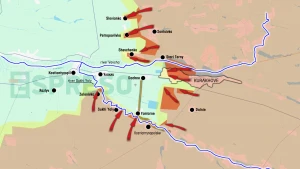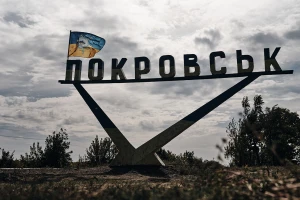
Ukraine reports new cases of Zaporizhzhia nuclear plant mining by Russian forces
Ukraine’s Energoatom company regularly receives reports of Russian mining of the Zaporizhzhia NPP. The occupying forces continue to use the plant as their military base
Energoatom President Petro Kotin said this during the telethon.
He noted that the situation at ZNPP remains difficult.
"In fact, the occupying Russian forces continue to use it as their military base. We regularly receive reports that they are mining our station," Kotin said.
He added that the radiation level at the ZNPP site is currently being measured using radiation monitoring sensors. They are located on the right bank of the Dnipro River, 5 km from the plant.
Also, according to Kotin, information from IAEA inspectors at the plant helps to understand what is happening there. However, he claims that the Russians do not allow the IAEA's representatives to enter all areas that require inspection.
"Despite the degradation of the equipment, we are looking forward to regaining control of the plant and resuming its full operation," Kotin summarized.
Situation at the Zaporizhzhia nuclear power plant
Russian forces occupied Zaporizhzhia NPP in late February 2022. Since then, there has been a constant presence of personnel and military equipment, which the invading Russian troops store in machine rooms and occasionally deploy to positions for shelling the territories of the Nikopol district in the Dnipropetrovsk region, located on the other side of the Kakhovka Reservoir.
The International Atomic Energy Agency (IAEA) has a monitoring mission at the station, which is supposed to ensure that the nuclear power plant is not used as a military base, that it is not attacked, and that no fire is initiated from the NPP. Power outages at the nuclear power plant occur regularly though. Occupiers began importing explosives to the Zaporizhzhia nuclear power plant last year.
In May 2023 information emerged that the Russian forces had placed explosives in the turbine room of the ZNPP’s fourth power unit. Additionally, the invading Russian forces have nearly completely destroyed the emergency readiness and response system at the nuclear power plant.
On June 22, the Director-General of the IAEA, after visiting ZNPP Grossi, stated that the situation at the plant is extremely unstable. On the same day, President Volodymyr Zelenskyy announced that intelligence had received information that Russia was considering a scenario for a terrorist act at the temporarily occupied Zaporizhzhia Nuclear Power Plant, which would cause a radiation release. He also emphasized that the world has sufficient strength to prevent any radiation incidents and even a radiation catastrophe – action must be taken and pressure must be applied. However, the spokesperson for the President of the Russian Federation, Dmitry Peskov, called Zelenskyy's statement a lie.
In turn, the Ministry of Foreign Affairs of Ukraine expects a clear assessment from the IAEA regarding Russia's criminal actions and has appealed to the international community, including the Group of Seven (G7) and the European Union, to take urgent measures to prevent a nuclear catastrophe at the Zaporizhzhia Nuclear Power Plant.
According to the ISW’s report, in the event of a terrorist act at the Zaporizhzhia Nuclear Power Plant, the Russian occupation forces in Enerhodar will not be able to control its consequences. Presumably, by indicating preparations for sabotage at the plant, the Russians are trying to persuade the Armed Forces of Ukraine to refrain from conducting counteroffensive operations in this area.
The Ministry of Internal Affairs has established headquarters for assistance, and rescue teams will conduct training to mitigate the consequences of a possible terrorist attack by Russians at the Zaporizhzhia Nuclear Power Plant.
The Head of the Main Intelligence Directorate, Kyrylo Budanov, stated that Russia has completed preparations for a terrorist act at the Zaporizhzhia Nuclear Power Plant.
On June 25, Zelenskyy held talks with Biden, Trudeau, and Duda, noting that "the world is not reacting adequately to the situation at the Zaporizhzhia Nuclear Power Plant."
Energoatom reported that as of 27 June, the situation at the temporarily occupied Zaporizhzhia nuclear power plant was under control, with the water level in the cooling pond stable.
On June 29, large-scale exercises were held in four regions of Ukraine to prepare for a possible terrorist attack on the ZNPP.
On June 30, the Main Intelligence Directorate reported that the occupying Russian forces were gradually leaving the ZNPP, and that Ukrainian employees who had signed a contract with Rosatom also received evacuation recommendations. In addition, the plant's staff received an order to blame Ukraine in any emergency situation.
The head of the Ukrainian Defense Ministry's Main Intelligence Directorate, Kyrylo Budanov, said that Russian troops have prepared everything for a man-made disaster at the Zaporizhzhia nuclear power plant.
In his turn, Ukrainian Armed Forces Commander-in-Chief Valeriy Zaluzhnyi said that the Ukrainian counteroffensive and the process of Ukraine regaining control over ZNPP would continue even despite Russian nuclear blackmail.
On 2 July, the mayor of the temporarily occupied Enerhodar, Dmytro Orlov, said that some Rosatom employees and collaborators who had signed a contract with the company had left ZNPP.
On July 4, the Ukrainian Armed Forces officially reported that Russian troops were preparing a provocation at ZNPP: Russians placed suspicious devices similar to explosives on the roof of power units 3 and 4.
President of Ukraine Volodymyr Zelenskyy spoke with French President Emmanuel Macron and warned him that Russia was preparing provocations at the Zaporizhzhia NPP.
On July 5, during a meeting of the OSCE Forum for Security Co-operation, the European Union made a statement that Russia must immediately stop actions that threaten the safety of nuclear facilities and withdraw its troops from Ukraine.
At the same time, IAEA Director General Rafael Grossi said that the agency had not detected any signs of mining at ZNPP. According to him, despite this, experts are "extremely wary". Subsequently, satellite images from Planet Labs, taken on the morning of July 5, showed unknown objects on the roof of the fourth power unit of the Zaporizhzhia NPP. The General Staff had previously reported that this particular power unit had been mined.
The head of the Main Intelligence Directorate, Kyrylo Budanov, said on July 6 that the threat of a terrorist attack at the Zaporizhzhia NPP was decreasing. However, the president of Energoatom later said that about 700 Russians are currently at the Zaporizhzhia NPP. The plant is mined, and machine gun nests are placed on the roofs of the power units. Energoatom also reported that the occupiers allow specialists from the Russian Federation to work at Zaporizhzhia NPP who do not have the necessary knowledge and skills to operate the plant.
On July 6, the first deputy head of Putin's administration, Serhiy Kiriyenko, arrived on the territory of the occupied ZNPP. The visit took place amid the publication of information about the Russians' mining of the ZNPP.
On July 7, the United States in the OSCE called on Russia to immediately withdraw its troops from ZNPP and return it to Ukrainian control, as it was concerned about reports of Russia's mining of the plant and plans for a "false flag" operation.
Also on July 7, the IAEA reported that its mission was able to inspect several facilities at the Zaporizhzhia NPP, except for the roof, but found no signs of explosives.
As of July 14, about 500 Russian military and Rosatom employees were at ZNPP, in particular, they were using the plant to shell the Zaporizhzhia and Dnipro regions.
- News













































